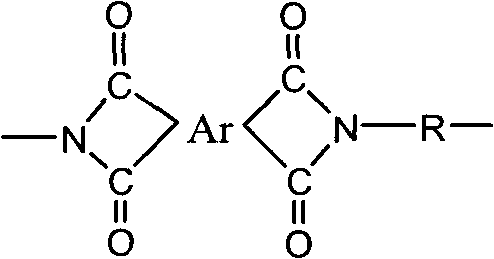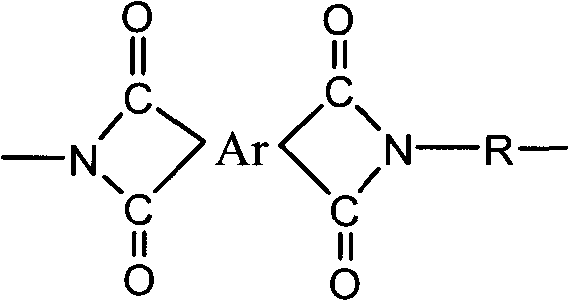Colorless and transparent polyimide nano-composite material membrane and preparation method thereof
A technology of nanocomposite materials and composite material films, which is applied in the field of polymer-based nanocomposite materials, and can solve the problems of reduced transparency and the like
- Summary
- Abstract
- Description
- Claims
- Application Information
AI Technical Summary
Problems solved by technology
Method used
Image
Examples
Embodiment 1
[0043] Quaternary ammonium salt (CTAB) was used as an intercalant to perform ion exchange modification treatment on montmorillonite to prepare organic montmorillonite. 0.0427 g of organic montmorillonite was added to 6.38 ml of N,N-dimethylacetamide (DMAc) solvent, and dispersed at 80° C. under strong mechanical stirring for 5 hours to obtain a DMAc solution of organic montmorillonite. In a three-necked reaction flask equipped with a stirrer, a thermometer and a nitrogen inlet, 6.5445 g of 2,2-bis[4-(4-amino-2-trifluoromethylphenoxy)phenyl]hexafluoropropane (0.01mol) dissolved in 45ml DMAc solvent, stirred to make the solution clear and transparent. Then add 1.9611g (0.01mol) of 1,2,3,4-cyclobutanetetracarboxylic dianhydride (CBDA) to the solution at one time, stir to dissolve it completely, and continue to react for 15-25 under a nitrogen atmosphere. Within hours, a transparent viscous liquid-polyamic acid (PAA) solution was obtained. The DMAc solution of the above-mentioned...
Embodiment 2
[0046] Will 0.0645g warp? -Aminopropyltriethoxysilane treated nano zinc oxide (particle size 30nm) was dispersed in 27.23ml of DMAc solvent under ultrasonic action, a uniform mixed solution was obtained after 2 hours, and moved to equipped with a stirrer and thermometer And nitrogen gas into the three-necked reaction flask. Dissolve 4.2833 g (0.01 mol) of 1,4-bis(4-amino-2-trifluoromethylphenoxy)benzene in the above solution, and stir to make the solution clear and transparent. Then add 2.1014g (0.01mol) of 1,2,4,5-cyclopentanetetracarboxylic dianhydride (CPDA) to the solution at once, stir to dissolve it completely, and continue to react for 15-25 under a nitrogen atmosphere. After hours, a transparent viscous liquid-polyamic acid solution with a solid content of 20 wt% by weight is obtained, and the intrinsic viscosity is 1.15 dL / g. Coat the polyamic acid solution on a clean glass plate, place it in a dry box with nitrogen protection, and increase the temperature according ...
Embodiment 3
[0049] In a three-necked reaction flask equipped with a stirrer, a thermometer and a nitrogen inlet, 6.5445 g of 2,2-bis[4-(4-amino-2-trifluoromethylphenoxy)phenyl]hexafluoropropane (0.01mol) was dissolved in 53.08ml of DMAc solvent and stirred to make the solution clear and transparent. Then add 2.2417g (0.01mol) of 1,2,4,5-cyclohexanetetracarboxylic dianhydride (CHDA) to the solution at once, stir to dissolve it completely, and continue to react for 15-25 under a nitrogen atmosphere. After hours, a transparent viscous liquid-polyamic acid solution with a solid content of 15 wt% by weight is obtained, and the intrinsic viscosity is 1.00 dL / g. Add 0.1529 g of tetraethyl orthosilicate (TEOS) and a little water to the polyamic acid solution. After stirring for 20 hours, the mixed solution is coated on a clean glass plate and placed in a dry box protected by nitrogen. The temperature is increased according to the following program: 80°C for 2hrs, 120°C for 1hr, 150°C for 1hr, 200...
PUM
| Property | Measurement | Unit |
|---|---|---|
| glass transition temperature | aaaaa | aaaaa |
| glass transition temperature | aaaaa | aaaaa |
| glass transition temperature | aaaaa | aaaaa |
Abstract
Description
Claims
Application Information
 Login to View More
Login to View More - R&D
- Intellectual Property
- Life Sciences
- Materials
- Tech Scout
- Unparalleled Data Quality
- Higher Quality Content
- 60% Fewer Hallucinations
Browse by: Latest US Patents, China's latest patents, Technical Efficacy Thesaurus, Application Domain, Technology Topic, Popular Technical Reports.
© 2025 PatSnap. All rights reserved.Legal|Privacy policy|Modern Slavery Act Transparency Statement|Sitemap|About US| Contact US: help@patsnap.com



